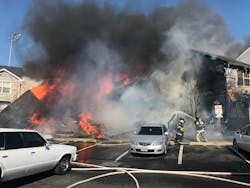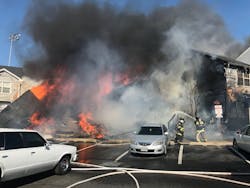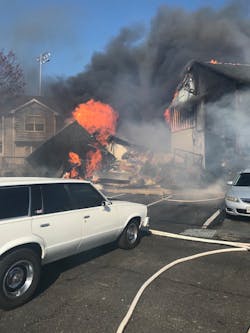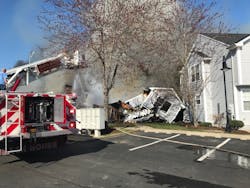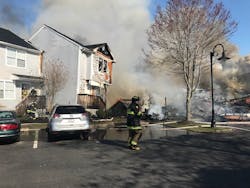Close Calls: A Fire Chief’s Worst Nightmare
If firefighting could be accomplished one task at a time, we (and the public) would all be in much better shape! Consider a few of the "standard" tasks that must be performed at a structural fire, including:
- Turnout
- Response
- Establish water
- Size up
- Stretch lines
- Force entry
- Search/rescue/removal/EMS
- Water on the fire
- Ventilation & related truck work
- Command positions
- Rapid Intervention
Wouldn't it be nice if we could tackle each of those one at a time? It would be nice, but that is far from our reality as firefighters. Our reality is that each of those must be performed pretty much simultaneously or the outcome is predictable. Just like a great band or an orchestra, there must be a plan, adequate staffing and a conductor to make sure everyone is playing together. That is, if the goal is for the band to sound great vs. each musician playing their parts one at a time.
While the performing of these fireground tasks may be “obvious” to some, it really is NOT when a department doesn't plan ahead. Planning to ensure that the predictable and needed resources (firefighters and apparatus) are dispatched to enable all that to be done immediately.
This month (and next) we are going to focus on a multi-occupancy dwelling where each of the above tasks had to be performed immediately, and the extreme challenges that come along with that.
Protection area and fire department
Chesapeake Beach and North Beach were incorporated in 1894 and 1900, respectively. The towns grew out of an idea to create a place not far from Washington, D.C., where people could get away. Chesapeake Beach evolved into the resort community with a wide variety of entertainment, North Beach became the beach cottage community. Both communities thrived until the 1960s and early 1970s when populations shifted to Maryland’s Atlantic Coast beaches. They went into decline until the 1990s when both experienced a “re-discovery” by commuters seeking a short commute to Washington and Annapolis and proximity to the Chesapeake Bay. Chesapeake Beach boasts 5,900 residents and North Beach has 2,000. Another 3,500 residents outside of the incorporated areas are directly served by the North Beach Volunteer Fire Department (NBVFD).
The Twin Beaches and surrounding area are protected by the NBVFD. Founded in 1926, the NBVFD is an all-volunteer department and was the first organized fire department in Calvert County, MD. The department’s 100+ member roll (30–35 active) runs approximately 2,300 calls per year, with 75 percent of the volume being EMS calls. The department runs between 15–20 working fires per year. The fleet is comprised of two Pierce pumpers (2018 and 2000 respectively), one Pierce 95-foot aerial platform (2016), one Spartan Gladiator heavy rescue (2015), one AEV EMS transport unit on a Kenworth chassis (2018, with a second unit on order), one brush truck, and several utility vehicles. The department also operates an inflatable boat and has a new fire rescue boat on order to provide fire and rescue service on the Chesapeake Bay and support the Calvert County Dive Team. NBVFD is part of Calvert County Fire and EMS, an organization of seven stations, an ALS team and dive team. All nine entities are fully volunteer. The department receives and gives automatic aid to nearby Anne Arundel and Prince George’s counties.
Our sincere thanks to North Beach Fire Chief Chris Mills for his enthusiastic participation in helping get their story out so that others can learn. We further thank Chief Mill's command staff, the NBVFD administrative staff, all the firefighters and departments that responded to this incident along with John B. Tippett Jr, director of Fire Programs for the National Fallen Firefighters Foundation (NFFF), and an NBVFD active member, for everyone’s assistance in sharing this important message.Initial dispatch, arrival and fire operations
On April 3, 2019, several members experienced an event that left the small communities and department shaken, but unbowed. A carelessly discarded smoking material started a fire in a pile of freshly spread mulch outside a row of four elevated, wood-frame townhomes. The fire, fueled by high winds, vinyl siding, lightweight construction, and delayed fire department notification, claimed the lives of two occupants and nearly claimed the lives of two firefighters attempting to locate the victims.
The townhomes were protected by automatic fire sprinklers. However, the fire starting on the outside of the structure and spreading via the unprotected areas rendered the sprinklers ineffective and contributed to trapping the occupants and nearly ending the lives of two firefighters. The 10 minutes from first 9-1-1 call to mayday was a period of intense confusion, helplessness, noble effort and significant tragedy for these small Twin Beaches communities.
At 16:11:33 hours on April 3, Calvert County 9-1-1 received its first call reporting a fire under the townhouse at the Courtyards at Fishing Creek Complex, 3885 Gordon Stinnett Avenue in Chesapeake Beach. While the call was being processed, Mills, just breaking for lunch at a nearby restaurant, received a phone call from a friend working in a nearby boatyard. The friend asked if the department was aware of a fire at the complex. Mills looked outside at the same time the run was being dispatched and the tones were being sounded, and he observed a large column of smoke approximately one mile away. He immediately headed toward the station. Calvert County dispatched a full first-alarm assignment response of five engines, two ladders, one heavy rescue, an EMS unit, an ALS unit, and the North Duty Chief. Callers reported people trapped in the building. The weather was clear and windy. Wind gusts ranged from 25–30 mph.
It should be noted that much like the entire Washington-Baltimore Region, automatic mutual aid with borderless response consisting of numerous departmentsbeing dispatched on the first alarm of fire, is nothing new in North Beach and Calvert County. This type of multi-agency response has been working very successfully in that area for decades.You will also notice an integrated command structure where mutual aid chiefs (including a mutual aid "duty" chief) can and do assume command positions. This is easily accomplished in any community where and when the focus is what's best for those having the fire, and those fighting the fire.
Mills and two firefighters (already at the station) responded to the scene with NBVFD Engine 11, a 2018 Pierce, 1,500-gpm pumper equipped with a 750-gallon tank. NBVFD Safety Officer Danny Morrison responded directly to the scene and arrived just ahead of Engine 11. Morrison confirmed a working fire on sides Alpha, Bravo and Charlie. He requested an immediate second alarm. Nearby Huntingtown Volunteer Fire Department Chief 6B, Assistant Chief Tim Clark, marked up as responding. Calvert Dispatch advised Chief 6B an occupant was advising that she was trapped in 3889 (the Bravo side end unit) and could not get out of her house. Chief 6B acknowledged the message and reiterated the request for a second alarm.
Engine 11 entered the complex and was met by a significant smoke condition that obscured the road and vision. Mills, driving Engine 11, slowed approach to avoid colliding with exiting vehicles and pedestrians that were appearing and disappearing in the smoke. The engine dropped a 3-inch supply line at the nearest hydrant (approximately 150 feet from the burning row) and proceeded to side Alpha of the row.
The four on-scene members of NBVFD (E11’s three-person crew plus Morrison) were faced with a row of four, elevated (built on pilings), wood-framed townhomes in various stages of fire involvement. All address numbers had been burned off the occupancies and the electric meters located on the Alpha side were violently arcing. The involvement ranged (left to right) with 90 percent involved (3889), 50–60 percent involved (3887), 40–50 percent involved (3885), and 20–30 percent involved (3883). Calvert County Dispatch advised they were on the phone with the occupant of 3889 who reported she was trapped in the second-floor interior bathroom of her home with her granddaughter. Bystanders told Engine 11’s crew that occupants were in 3887. Noting the end unit (3889) was fully involved and starting to separate from the adjoining unit, Mills ordered Morrison and one of the firefighters riding on Engine 11 to pull a 1½-inch attack line, make entry into 3887 and conduct a search for the victim. Calvert Dispatch contacted Command and advised the occupant stated she was going to attempt to get to a window at the rear of her home and that the house was collapsing. As the crew was advancing the line to 3887, 3889 collapsed.Mayday
Chief 6B arrived shortly behind Engine 11 from the Charlie side of the burning row and took command under the automatic aid agreement in place in Calvert County. He noted advanced fire involvement in three of the four townhomes from the Charlie side, and the end townhome (3889) beginning to pull away from the other three units. As he circled the row on foot, he noted Engine 11’s line in the front door of 3887 as 3889 was beginning to collapse. Within two minutes of taking command, he noted 3887 starting to separate from 3885. He ordered an evacuation of the building. Prior to the two members exiting, 3887 started to collapse. Clark observed one of the firefighters exit through a first-floor window as the townhome was collapsing but did not see anyone else exit. He (as the Incident Commander) immediately transmitted a mayday.
Morrison and Firefighter Max Ondrusek knocked down the visible fire on the exterior of 3887 so they could make entry. Inside the structure Morrison noted “…the whole place was lit up inside…” The heat was intense, but visibility was unusually clear. As they advanced the line and searched, Morrison noted they were making little headway with the line. He called back for another line but sensed they had diminishing time to locate any viable victims due to the intensity of the heat. As they reached the rear of the first floor, Morrison decided it was time to exit the building as the heat was continuing to intensify and the floor was starting to feel soft. He ordered Ondrusek to reverse travel and exit. As they neared the front door, Morrison felt the floor give way beneath his legs and observed his hand go through the floor in front of him. He recalls seeing Ondrusek jumping for the window and the air in his facepiece get intensely hot.NBVFD Engine 12, Tower 1 and Dunkirk Engine 52 arrived with crews of three shortly after the mayday was being called. They reported to Clark and received instructions to initiate rescue efforts for Morrison. As they approached the building, they saw Morrison’s helmet appear in a small opening that remained where the front door had been. The crews ran to Morrison, reached into the opening, pulled him out of the structure and moved him away from the building where they began removing his damaged PPE and treating him for injuries. Morrison reported not having any recollection between his last memory of the air in his facepiece getting hot and his PPE being stripped off in the front yard. Several firefighters sustained minor burns in the rescue effort.
Chief 6B cleared the mayday and firefighting operations resumed with Chief 6B declaring defensive operations. Additional units from the first and second alarms arrived and were put to work. The third and fourth townhomes also collapsed within a few minutes of the first two. Two exposures on the Bravo side also caught fire and collapsed, and an exposure on the Delta side was damaged as well. Morrison was treated for burns to his legs and arms, Ondrusek was treated for burns to his arms, and several members of the rescue team were treated for minor burns received during the rescue effort and removal of Morrison’s PPE.
The fire was extinguished after an extended period with elevated master streams and large handlines. Water supply from the municipal system was unable to support firefighting operations, so crews resorted to drafting from nearby Fishing Creek to obtain essential water. A search for the trapped occupants was initiated once the fire was declared under control. A woman and her granddaughter, both deceased, were found in the rubble of what had been the end unit townhome (3889). The Maryland State Fire Marshal investigated the fire and determined the cause to be discarded smoking materials in the mulch. Video obtained from bystanders captured the history of the fire from its earliest incipient stage and chronicled its explosive spread under, up and around the four units. Wind and combustible siding contributed to the rapid spread under the unprotected floors and around the exterior as well as delays in reporting the fire. The first call came from the occupant at 3885 reporting fire under her townhome. An estimated 14–17 minutes elapsed before the first call was placed to Calvert County Dispatch.Under control
All injured firefighters have returned to duty. The Twin Beaches communities mourned the loss of two of its newest residents. Calvert County Fire and Rescue convened an incident review team to investigate the incident. Mills convened an internal debrief for the first-arriving units using the NFFF After-Action Review process. Many of the results will be covered in Part 2 of this article, where we will look at:
- What was the mission?
- What went well?
- What could have gone better?
- What might have been done differently?
- Who needs to know?
The NBVFD, under Mills’ leadership, is committed to taking the lessons learned from this incident and sharing them with the fire service at large. Every fire department is just one box alarm away from encountering a similar situation.
Next month
Next month we will hear from the firefighters and fire officers from this fire and discuss what went right, what should be done differently and thoughts that your department should consider.
About the Author
Billy Goldfeder
BILLY GOLDFEDER, EFO, who is a Firehouse contributing editor, has been a firefighter since 1973 and a chief officer since 1982. He is deputy fire chief of the Loveland-Symmes Fire Department in Ohio, which is an ISO Class 1, CPSE and CAAS-accredited department. Goldfeder has served on numerous NFPA and International Association of Fire Chiefs (IAFC) committees. He is on the board of directors of the IAFC Safety, Health and Survival Section and the National Fallen Firefighters Foundation.
